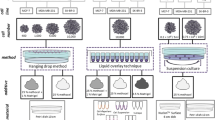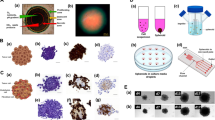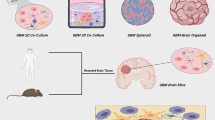Abstract
Firefly luciferase catalyzes the emission of light from luciferin in the presence of oxygen and adenosine triphosphate. This bioluminescence is commonly employed in imaging mode to monitor tumor growth and treatment responses in vivo. A potential concern is that, since solid tumors are often hypoxic, either constitutively and/or as a result of treatment, the oxygen available for the bioluminescence reaction could be reduced to limiting levels, leading to underestimation of the actual number of luciferase-labeled cells during in vivo experiments. We present studies of the oxygen dependence of bioluminescence in vitro in rat 9 L gliosarcoma cells tagged with the firefly luciferase gene (9Lluc). We demonstrate that the bioluminescence signal decreases at pO2 ⩽ 5%, falling by approximately 50% at 0.2% pO2. Further experiments showed that the critical threshold for the initiation of metabolic depression in these cells was around 5%. Below this level, the decrease of oxygen saturation was followed by a decrease in intracellular ATP due to the reduction of mitochondrial membrane potential. Hence, the data suggest that the decrease of intracellular ATP level in vitro is the limiting factor for bioluminescence reaction and so is responsible for the reduction of bioluminescence signal in 9Lluc cells in acute hypoxia, rather than luciferase expression or oxygen itself.
Similar content being viewed by others
Notes and References
G. B. Sala-Newby, C. M. Thomson and A. K. Campbell, Sequence and biochemical similarities between the luciferases of the glow-worm Lampyris noctiluca and the firefly Photinus pyralis, Biochem. J., 1996, 1, 761–7.
W. D. McElroy and M. DeLuca, Bioluminescence and Chemilumines-cence, Academic Press, New York, 1981, pp. 179–86.
C. H. Contag and B. D. Ross, It’s not just about anatomy: In vivo bioluminescence imaging as an eyepiece into biology, J. Magn. Reson. Imaging, 2002, 16, 378–87.
A. Rehemtulla, L. D. Stegman, S. J. Cardozo, S. Gupta, D. E. Hall, C. H. Contag and B. D. Ross, Rapid and quantitative assessment of cancer treatment response using in vivo bioluminescence imaging, Neoplasia, 2000, 2, 491–495.
E. H. Moriyama, S. K. Bisland, L. Lilge and B. C. Wilson, Biolumi-nescence Imaging of the Response of Rat Gliosarcoma to ALA-PpIX Mediated Photodynamic Therapy, Photochem. Photobiol., 2004, 80, 242–9.
J. T. Beckham, M. A. Mackanos, C. Crooke, T. Takahashi, C. O’Connell-Rodwell, C. H. Contag and E. D. Jansen, Assessment of cellular response to thermal laser injury through bioluminescence imaging of heat shock protein 70, Photochem. Photobiol., 2004, 79, 76–85.
B. W. Rice, M. D. Cable and M. B. Nelson, In vivo imaging of light-emitting probes, J. Biomed. Opt., 2001, 6, 432–40.
T. M. Sitnik, J. A. Hampton and B. W. Henderson, Reduction of tumour oxygenation during and after photodynamic therapy in vivo: effects of fluence rate, Br. J. Cancer, 1998, 77, 1386–94.
B. Chen, B. W. Pogue, X. Zhou, J. A. O’Hara, N. Solban, E. Demidenko, P. J. Hoopes and T. Hasan, Effect of tumor host microenvironment on photodynamic therapy in a rat prostate tumor model, Clin. Cancer Res., 2005, 15, 720–7.
I. P. van Geel, H. Oppelaar, Y. G. Oussoren and F. A. Stewart, Changes in perfusion of mouse tumours after photodynamic therapy, Int. J. Cancer, 1994, 15, 224–8.
J. W. Hastings, Oxygen concentration and bioluminescence intensity, J. Cell. Comp. Physiol., 1952, 39, 1–30.
I. Cecic, D. A. Chan, P. D. Sutphin, P. Ray, S. S. Gambhir, A. J. Giaccia and E. E. Graves, Oxygen sensitivity of reporter genes: implications for preclinical imaging of tumor hypoxia, Mol. Imaging., 2007, 6, 219–28.
H. Shapiro, The light intensity of luminous bacteria as a function of O2 pressure, J. Cell. Comp. Physiol., 1934, 4, 313–28.
D. W. Whillans and A. M. Rauth, An experimental and analytical study of oxygen depletion in stirred cell suspensions, Radiation Res., 1980, 84, 97–114.
M. Ebert and A. Howard, Current Topics in Radiation Research, North-Holland Publishing Company, London, vol. V, 1969.
E. C. Slater, Application of inhibitors and uncouplers for a study of oxidative phosphorylation, Methods Enzymol., 1967, 10, 48–57.
G. S. Timmins, F. J. Robb, C. M. Wilmot, S. K. Jackson and H. M. Swartz, Firefly flashing is controlled by gating oxygen to light-emitting cells, J. Exp. Biol., 2001, 204, 2795–801.
R. Rampling, G. Cruickshank, A. D. Lewis, S. A. Fitzsimmons and P. Workman, Direct measurement of pO2 distribution and bioreductive enzymes in human malignant brain tumors, Int. J. Radiat. Oncol., Biol., Phys., 1994, 29, 427–31.
P. W. Hochachka, L. T. Buck, C. J. Doll and S. C. Land, Unifying theory of hypoxia tolerance: molecular/metabolic defense and rescue mechanisms for surviving oxygen lack, Proc. Natl. Acad. Sci. USA, 1996, 93, 9493–8.
O. Warburg, The Metabolism of Tumors, London, Constable Co. Ltd., 1930.
X. L. Zu and M. Guppy, Cancer metabolism: facts, fantasy, and fiction, Biochem. Biophys. Res. Commun., 2004, 488, 119–133.
C. Koumenis, C. Naczki, M. Koritzinsky, S. Rastani, A. Diehl, N. Sonenberg, A. Koromilas and B. G. Wouters, Regulation of protein synthesis by hypoxia via activation of the endoplasmatic reticulum kinase PERK and phosphorylation of the translation initiation factor eIF2a, Mol. Cell. Biol., 2002, 22, 7405–16.
S. Coutier, L. N. Bezdetnaya, T. H. Foster, R. M. Parache and F. Guillemin, Effect of irradiation fluence rate on the efficacy of photody-namic therapy and tumor oxygenation in meta-tetra (hydroxyphenyl) chlorin (mTHPC)-sensitized HT29 Xenografts in nude mice, Radiat. Res., 2002, 158, 339–45.
V. H. Fingar, P. K. Kik, P. S. Haydon, P. B. Cerrito, M. Tseng, E. Abang and T. J. Wieman, Analysis of acute vascular damage after photodynamic therapy using benzoporphyrin derivative (BPD), Br. J. Cancer, 1999, 79, 1702–8.
V. H. Fingar, T. J. Wieman and K. W. Doak, Mechanistic studies of PDT-induced vascular damage: evidence that eicosanoids mediate this process, Int. J. Radiat. Biol., 1991, 60, 303–9.
Author information
Authors and Affiliations
Corresponding author
Rights and permissions
About this article
Cite this article
Moriyama, E.H., Niedre, M.J., Jarvi, M.T. et al. The influence of hypoxia on bioluminescence in luciferase-transfected gliosarcoma tumor cells in vitro. Photochem Photobiol Sci 7, 675–680 (2008). https://doi.org/10.1039/b719231b
Received:
Accepted:
Published:
Issue Date:
DOI: https://doi.org/10.1039/b719231b




